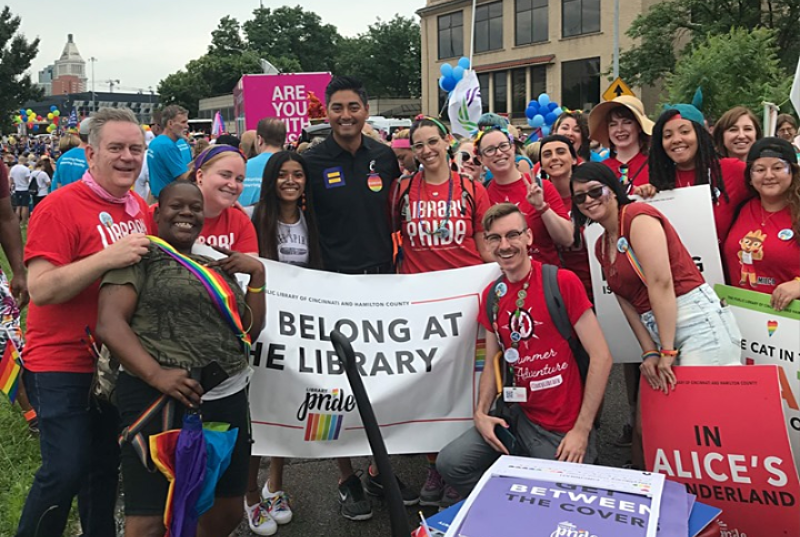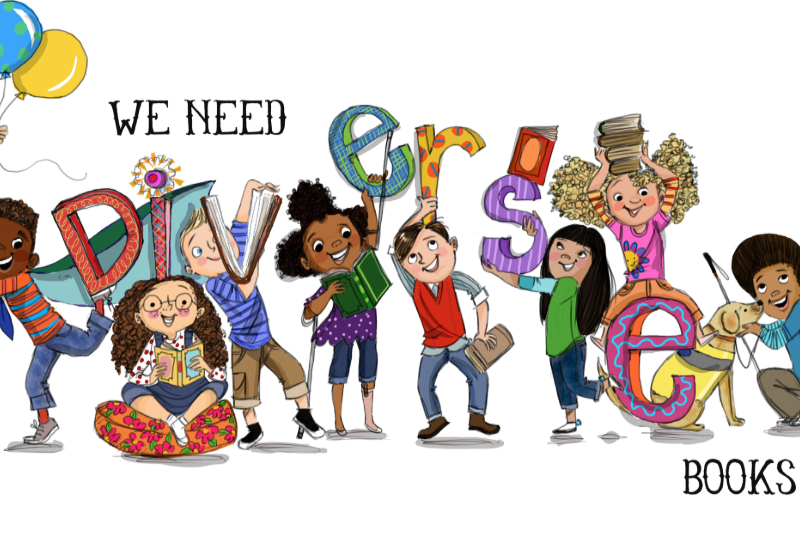 Written by Victoria Thompson, Line Assistant Physical Processing, Cataloging & Processing
Written by Victoria Thompson, Line Assistant Physical Processing, Cataloging & Processing
The American Library Association (ALA) states that “diversity is a fundamental value of the association and its members, and is reflected in its commitment to recruiting people of color and people with disabilities to the profession and to the promotion and development of library collections and services for all people.”
Across the country, libraries and archives, both public and academic, are taking steps toward creating an environment that is diverse, equitable, and inclusive. Updates to everything from classification systems to materials are being debated and implemented. The national conversation about what diversity looks like, how equity is achieved, and who is in need of being included is constantly changing. As public libraries, we have a vested responsibility to the communities we serve to be at the forefront of civil progress.
At the Public Library of Cincinnati and Hamilton County, we have the privilege of serving a city that is already a part of that conversation. On October 9th, 2019, Cincinnati became the second city in the country to pass a law specifically banning discrimination based on natural hair. Cincinnati has hosted its annual LGBTQ+ Pride, opens a new window celebration since the first march on Fountain Square in 1973. Our Downtown Main Library is located just a streetcar ride away from the National Underground Railroad Freedom Center.
There are many ways to see how the Library works to uphold our mission statement and “be a dynamic force in the community”. We host English classes for speakers of other languages; we march in the Pride parade; we hold a Memory Cafe for people with Alzheimer’s or dementia; we have a Teen Advisory Board; we stage a Read-In during Black History Month; we’ve been holding Community Listening Sessions to better understand the needs of the people we serve and, together, direct the future of our library.
Personally, I’ll never forget the day, during my first few months with the Library, that a woman came up to my desk and said, “I can’t tell you how glad I am to see you--I didn’t know that people like us work here.” We absolutely do. But that interaction, seared as it is in my memory, happened when I was still working a circulation desk. In my current role in the Cataloging and Processing Department, I no longer assist our patrons face-to-face.
I do get to see nearly every new item we add to our collection. I get to help prepare these items for distribution to our 41 locations where they’ll be circulated to the public. I don't get to physically put these into a patron’s hands, or see their smiles when they find just the right thing on our shelves.
In libraries, one of the easiest methods we have to quantify how we are working to promote diversity is by assessing the staff of a branch or department and asking simply, “Do we look like the people we’re serving?” But finding an answer to that question becomes a lot more difficult once you move behind the scenes. “Technical Services” is a big umbrella term for the Library workers who operate in those behind-the-scenes areas.
At the Public Library of Cincinnati and Hamilton County, it generally refers to our Cataloging & Processing, Conservation Services, and Materials Selection & Acquisition departments. These are the people busy working in the stacks and at our library’s new Distribution Center, doing the valuable and unseen work that enables our branch staff to connect people to the materials they need when they need them.
While it is absolutely vital that we encourage communication and collaboration with the branches, to ensure that everyone has access to the resources that best serve their community, Library Technical Services as a whole tends to promote an internal culture of independence and objectivity. Such a culture has a great deal of merit. There’s a kind of ruthlessness that can come from maintaining a Library’s collection; no one wants to withdraw an item from circulation, and if book lovers and Library workers had three wishes, “unlimited room in the stacks” would certainly make the list (along with “more time to read” and “perpetually-refilling coffee pots”).
The problem with books is that people keep making them, even when your shelves are already full! At home, I can buy more bookshelves. Sometimes, things just have to go. At the Library, there’s a whole team of people making sure that we have enough of the new materials our customers want to read (or watch, or listen to, or create, or use), while also ensuring that we aren’t losing access to vital resources just because a little time has passed. It’s an amazingly delicate balance, in which a lack of bias certainly comes in handy.
But the sad truth is that nobody can be completely free of bias. No one can be absolutely objective. The belief that such a thing could be possible only moves us further toward marginalizing certain voices and amplifying others. We must remember that the necessary response to bias is not objectivity, but equity--an ideology that allows us to take into account the vastness of human experience and appreciate each in its own right.
It is this goal of equity that has given rise to groups such as #WeNeedDiverseBooks, opens a new window, the It Gets Better Project, opens a new window, the ALA’s Committee on Diversity, opens a new window, the Jewish Book Council, opens a new window, the Well-Read Black Girl, opens a new window book-club-turned-literary-festival, REFORMA, opens a new window, American Indians in Children’s Literature, opens a new window (AICL), GLSEN, opens a new window, Lee & Low Books, opens a new window, Marley Dias’ #1000BlackGirlBooks, opens a new window drive, the #OwnVoices, opens a new window movement, and so much more. Many of these programs, groups, and movements are geared toward younger readers. Most of them didn’t exist when I was that age, and I firmly believe that, if they had, I would have found my way into Library work much sooner than I actually did. The fact the Library is committed to pushing forward towards the goal of these organizations makes my work all the more meaningful.
The thought makes me so excited to see what the coming generations are capable of, with this much access to so many amazing resources and support systems. But the work of promoting equity, diversity, and inclusion isn’t something that can be put off until someone more qualified comes along. What the hashtag doesn’t tell you is that we need diverse books now, not in 10, 20, or 30 years when the kids are all grown up and can do the job for us. The Library is committed to making this a reality.
Marginalization is like a weed, and if we aren’t getting our hands dirty and pulling out as much as we can now, the situation is going to look far worse when the next gardeners come along. I love my department and colleagues, and I know that the work we do is vital and valuable to the Library and our customers. But even so, even now, I'm often having to stop and check myself. Am I working this hard, volunteering for more projects, registering for conferences and trainings because I actually want them? Or am I doing it because I'm young, and a woman, and biracial, and I don't have a Master's degree, so I feel like I have to prove that I deserve to be here? And what do I do if the answer is: "Both"?
These aren't new questions. In fact, it feels like I've been asking them for my whole life. But, whoever you are, trying to be active and vocal in promoting diversity, equity, and inclusion in your workplace and the world around you brings a whole host of new and challenging questions. How do you take a stand for diversity without tokenizing yourself or speaking over someone else's experiences? What do you do when you face burnout or "diversity fatigue"? How do you seek out a mentor without adding to their burden, or when none of the people with the necessary experience to do so look like you? How do you find the tools to dismantle systems of oppression that have been in place long before you got here?
I wish I knew the answer to all of these questions. But I take a lot of heart by reminding myself that I'm not the only person asking them--that across the country, across the world, in libraries, and courthouses, and on Goodreads, and Twitter, people are coming forward to ask these questions with courage, hope, and the certainty that we will find the answers, together. Each day, we can work towards creating a more diverse, equitable, and inclusive tomorrow.





Add a comment to: Feeling seen behind the scenes at the Library